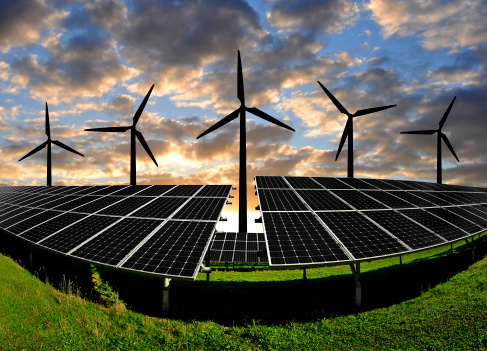U.S. electricity generated from utility-scale renewable energy projects is expected to grow by 9% this year, based on projections in the U.S. Energy Information Administration’s (EIA) latest Short-Term Energy Outlook. Much of the growth comes from new installations of wind and solar plants and increases in hydroelectric generation after a relatively dry 2015.
In 2016, EIA says electricity from utility-scale renewable sources is expected to account for 14% of the total electricity generated in the U.S., with wind and solar contributing 5.2% and 0.8%, respectively.
Increases in renewable capacity and generation are influenced by federal, state and local policies. Interestingly, EIA expects the extension of the federal investment and production tax credits passed at the end of 2015 to have little effect on renewable capacity additions in 2016 because most utility-scale plants that will enter service this year are already being developed, including several wind and solar projects. Impacts of the extensions in 2017 depend on how many wind and solar projects are already in the development queue but not yet under construction, according to the agency.Furthermore, EIA says the U.S. Environmental Protection Agency’s (EPA) approval of the Clean Power Plan in August 2015 may also affect new renewable builds over the next several years, but these near-term effects will be less certain until states start to lay out their implementation plans.
EIA expects continued growth in utility-scale solar power generation, which is projected to average 129 GWh/day in 2017 – an increase of 45% from the 2016 level. Utility-scale solar power will average 1.1% of total U.S. electricity generation in 2017. Although solar growth has historically been concentrated in customer-sited distributed generation installations (rooftop panels), EIA expects utility-scale solar capacity will increase by 126% (13 GW) between the end of 2014 and the end of 2016, with 4.9 GW of new capacity being built in California. Other states leading in utility-scale solar capacity additions include North Carolina and Nevada, which, combined with California, account for about two-thirds of the projected utility-scale capacity additions for 2015 and 2016.
Although solar growth has historically been concentrated in customer-sited distributed generation installations (rooftop panels), EIA expects utility-scale solar capacity will increase by 126% (13 GW) between the end of 2014 and the end of 2016, with 4.9 GW of new capacity being built in California. Other states leading in utility-scale solar capacity additions include North Carolina and Nevada, which, combined with California, account for about two-thirds of the projected utility-scale capacity additions for 2015 and 2016.
EIA says wind power capacity, which starts from a significantly larger installed capacity base than solar, grew by 13% in 2015, and it is forecast to increase by 14% in 2016 and by 3% in 2017.
Changes in electricity generation from other renewable fuels in 2016 are expected to be flat (in the case of biomass) or relatively modest (4% increase in geothermal). Electricity generation from hydropower facilities is expected to increase 5% in 2016 based on expectations of high precipitation during El Nino, with water levels recovering from the relatively dry years in recent history.
More information about electricity projections is available here.




